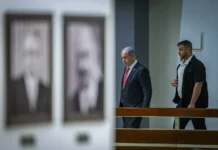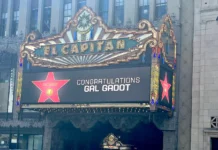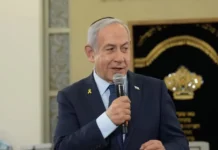On Dec. 15, 1970, a small item appeared at the top of page three of The New York Times under the jarring headline, ‘Soviets Reported Trying 11, Mostly Jews, in Hijacking.’ Few could have predicted that the trial of those young Jewish activists held in a grim Leningrad courtroom would transform the lives of millions of people on both sides of the Iron Curtain.
The accused were part of a group that tried to carry out a plan in June 1970 to take over a small plane that would then fly under the radar across the Soviet border to freedom.
It was a radical scheme whose goal was to focus attention on the plight of Jews in the Soviet Union and their desire to emigrate. Those who took part were seasoned activists who understood that there was a far greater likelihood of being killed or arrested than of reaching Sweden, but they went ahead anyway. The result? Arrests, death sentences, long years in the Gulag—and the jumpstart to a movement that ultimately brought freedom to millions of Soviet Jews, and strengthened the identity and commitment to Jewish peoplehood of untold others in the West.
Fifty years later, the names of those courageous young Soviet Jews and their daring deed, called “Operation Wedding” (the Jewish activists claimed to be traveling together to a wedding), remain largely forgotten. Many of those involved wonder why the Jewish world has paid little attention to such a positive, inspiring and dramatic movement. Now, two new educational initiatives, one in Hebrew and the other in English, hold the promise of reviving interest.
Kuznetsov, along with Mark Dymshits—the pilot who was to fly the captured plane—was sentenced to death at the Leningrad tribunal on Dec. 24 1970 for his role as one of the main architects of the so-called hijacking plan. The Soviets hoped to make an example of the group and instill fear in the millions of Jews living under Soviet rule. By Dec. 31, however, the court backtracked and the death sentences were commuted to 15 years imprisonment, and the sentences of most of the other defendants, including Anat’s mother, Sylva Zalmanson, were also reduced.

The force of swift international pressure, ranging from mass demonstrations in Israel to official protests from the leaders of 24 countries, and a deluge of protests from the pope, Nobel Prize winners and leading newspapers led to the commutations. The Kremlin campaign to bring the nascent Jewish freedom movement to its knees had proven to be a dismal failure.
In fact, when the stirring words of Sylva Zalmanson in the courtroom were broadcast by the BBC and Voice of America Radio, Jews from all over the Soviet Union who were brave enough to tune in were inspired and emboldened.
“Even now, I do not doubt for a minute that I will live in Israel,” proclaimed Sylva. “This dream, illuminated by 2,000 years of hope, will never leave me. Next year in Jerusalem! And now, I repeat: ‘If I forget you, O, Jerusalem, let my right hand wither.’ ”
Natan Sharansky, who was a student at the time, told JNS “Sylva’s words gave us a very big push.” The period of the trial was the first time Sharansky realized that strong public opinion could actually sway the Soviet regime. “We knew the power of the Soviet Union, but now we understood that there was a force that could influence the country. It was the first time that it brought home the idea that there is a movement, that world Jewry showed its strength and mobilized to help us.”
‘This was the moment we had to do something’
From the perspective of Jewish student activists in the West, things weren’t quite so clear. On the one hand, recalls Glenn Richter, co-founder of the New York-based Student Struggle for Soviet Jewry (SSSJ), “the actions of the Leningrad trial defendants super-charged the Soviet Jewry movement. There was tremendous agitation and the realization that if these Jews were fighting for their lives, then this was the moment we had to do something.”
But, Richter tells JNS, there were different reactions in the United States to the trial. “The establishment organizations went to see (President Richard) Nixon; the JDL (Jewish Defense League, based in Brooklyn, N.Y., headed by Rabbi Meir Kahane) made death threats against Soviet diplomats; and SSSJ took to the streets and marched on the Soviet Mission.”

American-born Israeli author and journalist Yossi Klein Halevi was a high school student in New York in 1970 and already an active member of SSSJ. “I feel as if I remember every minute of that period. It was such a formative time for me,” he tells JNS. “We saw this as a historic moment. I made a clear decision that I was going to take on some of the desperation of the Leningrad activists. That resulted in several concrete steps. I made the shift from SSSJ to JDL. I began getting arrested, disrupting concerts of Soviet artists, harassing Soviet diplomats in the street.”
During Passover 1973, Klein Halevi, who is the son of Holocaust survivors, traveled to the former Soviet Union and took part in a sit-in at OVIR (the Soviet Visa bureau) that he describes as “a direct emotional response to the Leningrad trial. If young Jews in the FSU could reach a point where they were willing to risk their lives to push open the gates, then we in America needed to up the game,” he explains. “We needed to move from a peaceful protest that didn’t entail any physical risks to putting ourselves in harm’s way.” Klein Halevi acknowledges that the movement to free Soviet Jews “was just as much about us as it was about them.”
In the United Kingdom, students like Abie (“Avi”) Lehrer had been actively campaigning with the Universities Committee for Soviet Jewry since the mid-1960s. But similar to the situation in the United States, Lehrer relates to JNS that it took the Leningrad trials to galvanize the attention of the Jewish establishment. His main memory of the period surrounding the Leningrad arrests and trial is the trip he took to visit refuseniks during the High holydays of 1970. There was little discussion of the arrests, he recounts, since the Soviet media had kept silent about the arrests of the Jews while they prepared for the show trial.
Lehrer did witness the immediate after-effects of the trial when he arrived in Israel where he spent the remainder of the academic year. During 1970, only 1,000 Jews had succeeded in emigrating from the FSU. In the months following the trial, Soviet emigration policy eased and 15,000 Jews left during 1971. “I went to the airport to greet them, and some were people I had met in the Soviet Union the previous October. We danced together in the hall of the airport. It was fantastic!” exclaims Lehrer.

While some Jews started legally streaming out of the Soviet Union, those arrested began serving their lengthy prison terms. Sylva Zalmanson, 76, the only woman sentenced, tells JNS that she thought she would never survive her 10-year sentence. In the end, she was released after four years, including a period of six months in solitary confinement. “I know how to be alone. I have no trouble to be in isolation during corona because of my experiences,” she quips today.
Looking back, she says what kept her going was the knowledge “that people in the free world supported us, and we didn’t feel alone in this struggle. Also, you are with people in the camp; it’s another life you learn there. You test yourself. It’s a school for life.”
Her daughter, Anat, adds that her parents knew their friends were gaining their freedom because of their actions. “I feel our actions were not in vain,” emphasizes Sylva. “We did something huge, and we’re proud of it. I have not one second of resentment to those who got out without spending time in prison.”
As a key organizer of the Jewish underground in Riga, 73-year-old Yosef Mendelevich served the longest sentence of any of the Jews tried in Leningrad in 1970. He has lived in Jerusalem with his wife, and their many children and grandchildren, since his release in 1981 after spending 11 years in Soviet labor and prison camps.
Mendelevich explains to JNS that he’s always astonished when Israelis or Americans ask how he survived his sentence. “There was no difficulty in staying in the Gulag. I was born in Soviet Russia, educated in Soviet Russia, worked in Soviet Russia, so I was used to a condition of life in Soviet Russia and the Gulag was just part of Soviet Russia, almost the same. There was never a real problem to do what I did in the Gulag. I realize it’s hard for people to understand if they never experienced Soviet Russia.”
For Mendelevich, the decision to take part in the plan to capture the plane was another stage of openly confronting the Soviet regime. “Either way, whether we succeeded or were arrested, the consequence would be publicity,” he says. At one point in early 1970, the activists in Leningrad sent word to Israel to ask whether to go ahead with the plan. The response was negative—no government could approve of a plan to steal an airplane—so a number of the original planners dropped out.
“Even now, I do not doubt for a minute that I will live in Israel,” proclaimed Sylva Zalmanson. “This dream, illuminated by 2,000 years of hope, will never leave me. Next year in Jerusalem! And now, I repeat: ‘If I forget you, O, Jerusalem, let my right hand wither.’ ”
They felt the plan would be counterproductive because everyone was being watched by KGB and would certainly be arrested in the airport. Then the members of the Jewish cultural movement would be arrested and that nascent movement would be stifled. “I discussed it with my mentor in Riga,” recalls Mendelevich. “He told me that the Jewish educational movement, which was then underground, could save maybe 1,000 to 2,000 people, but the only way to save our people from assimilation and get them to leave is to break through and do something dramatic. The people I approached and drafted to the group were friends who had been active for years in the underground movement who were in danger of being arrested anyway. It was a group created out of our solidarity with Israel.”
He speculates that the limited current interest in the story of the Soviet Jewry movement is because “people are not interested in heroes. People are astonished to find I’m still alive!” Since the publication of his book Unbroken Spirit (Gefen, 2012) in English, Mendelevich has traveled all over the world to tell the story, but says he is rarely invited to non-Orthodox communities.
“This was one of the greatest moments in all of Jewish history. Who today even talks about it?” asks American-born Israeli author and journalist Yossi Klein Halevi. “The movement has been almost completely forgotten. It’s partly the fault of those of us who were in it. We all moved on. We checked that box. We did it, and gave ourselves a deserved pat on the back and went on with our lives. We neglected to tell those who came after us about what actually happened.”
‘The importance of Jewish solidarity’
Anat Zalmanson-Kuznetsov, now a documentary filmmaker, was born in Israel following her father’s release from the Gulag. She told JNS that she was not aware of her parent’s underground Jewish activities or the details of their years in Soviet prisons and labor camps while she was growing up. “My parents didn’t speak about it all. I only learned about it from watching TV or having teachers or people in the street approach me and say, ‘Your parents are heroes,’ but nothing beyond that.”
She concluded that “people don’t know anything about this inspiring story because we haven’t taught it, and it’s not made approachable for the younger generation. Her first effort to correct that was to produce and direct an award-winning documentary in 2016 about her parents’ role in the hijacking attempt.

Now, the Refusenik Project that she co-directs with Chana German, director of the Lookstein Center at Bar-Ilan University in Ramat Gan, utilizes a lot of the research Zalmanson-Kuznetsov did for the film. The English-language site went live last year with material geared for school-age youth for use in both formal and informal learning settings.
“The idea is to keep the story of the Soviet Jewry struggle alive and be relevant for today’s kids.”
“Fake news? Show them archives of KGB and Soviet media that were complete lies. How to get protest and get media attention without violence. They can learn a lot from the Soviet Jewry movement.” The important thing, according to Zalmanson-Kuznetsov, is to focus on the positive—the importance of Jewish solidarity and how to win a campaign, and not on the suffering.
For Morey Schapira, a former President of the Union of Councils for Soviet Jews, who is a consultant to both educational programs created by Zalmanson-Kuznetsov, the refuseniks were modern-day Maccabees. “They should be honored in a similar manner,” he tells JNS. “Anyone concerned with the terrible growth in anti-Semitism in the world today should learn how the refuseniks stood up to Soviet anti-Semitism.”
The Israeli “Let My People Go” portal created by Zalmanson-Kuznetsov was created in partnership with Nativ, a branch of the Prime Minister’s Office responsible for Israel’s relations with the countries of the FSU. The site offers creative, interactive lesson plans for all grades based on Nativ’s huge stash of unique archival materials. Nativ is working with the Ministry of Education to adopt the portal to offer to teachers in all schools. Part of the Israeli school curriculum requirement is “peoplehood” and “that’s a perfect fit,” Sophie Kotzer, head of Nativ’s Research and Information Division told JNS.
Much of the material used for the new portal had to be declassified before being made available to the public. Nativ’s activities in the FSU included clandestine efforts to provide Jewish cultural material and Zionist education to Jews in all corners of the Soviet empire. Until 2002, Nativ was a division of Israel’s Intelligence Service and is subject to Israel’s Archives Law that all material can be released only after 30 years.
“Now the time is right,” says Kotzer. The material is becoming available, and Nativ director Neta Briskin Peleg has prioritized education. “Nobody knows what we do. No one knows what our mission was behind the struggle. I want people to know what the Israeli government did for Soviet Jewry,” she adds.
Other online events marking the 50th anniversary of the Leningrad Trials include a conference in English titled “The Jewish National Movement in the USSR, Marking the 50th Anniversary of ‘Operation Wedding,’ ”sponsored by the Goldstein-Goren Diaspora Research Center, the Museum of the Jewish People at Beit Hatfutsot and the Jewish Agency for Israel.
Several former U.S. Soviet Jewry activist leaders are sponsoring an online screening for teachers of the documentary film “Operation Wedding,” followed by a discussion with Sylva Zalmanson and Anat Zalmanson-Kuznetsov.


























